Cloud Computing: Features, Challenges, Regulatory and Ethical Obligations, and Mitigation Techniques
VerifiedAdded on 2023/06/08
|10
|2272
|270
AI Summary
This briefing paper provides a brief description of cloud computing, its features, challenges faced by ICT professionals, regulatory and ethical obligations, and mitigation techniques for issues. It also includes a table of contents, references, and conclusion.
Contribute Materials
Your contribution can guide someone’s learning journey. Share your
documents today.
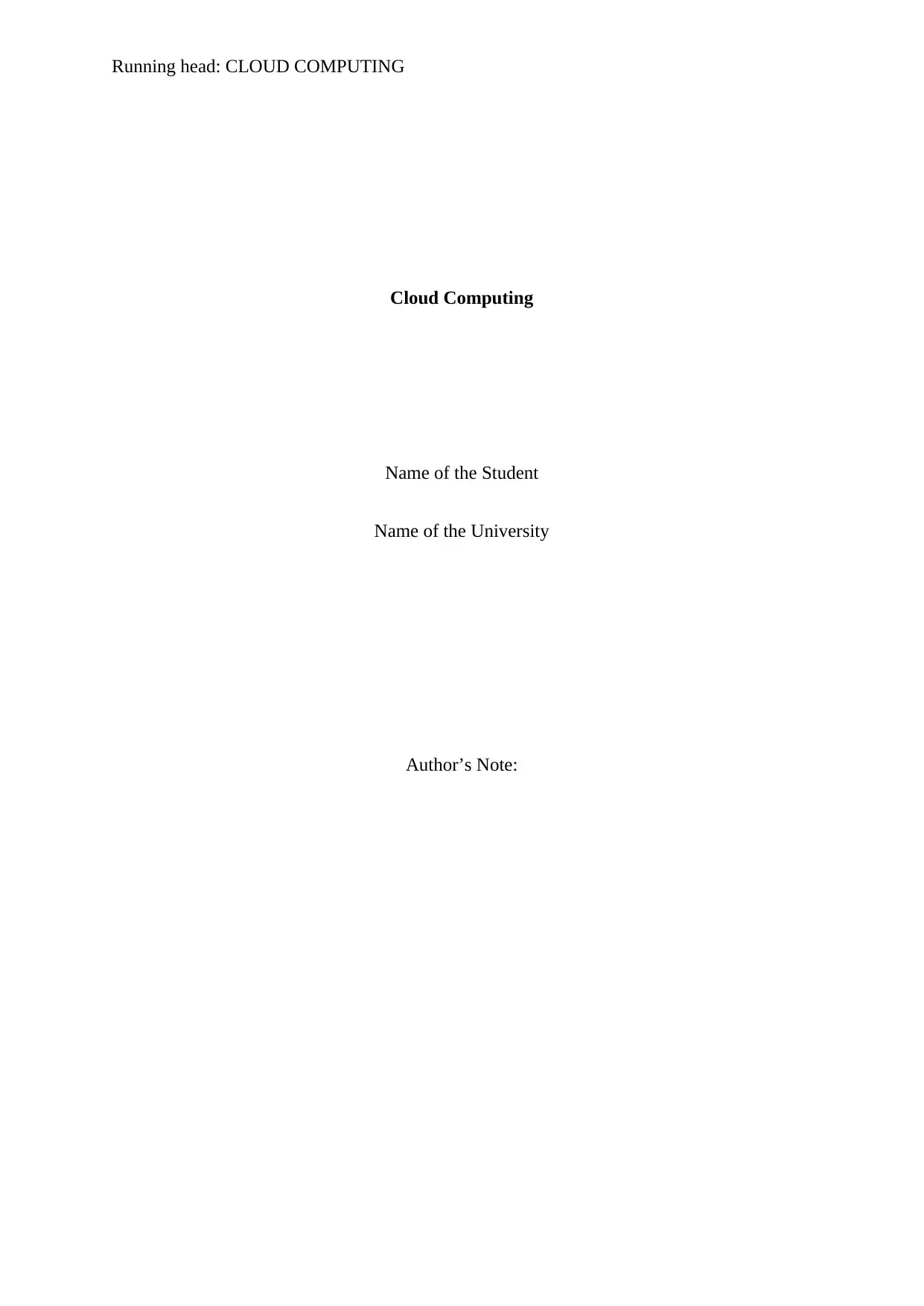
Running head: CLOUD COMPUTING
Cloud Computing
Name of the Student
Name of the University
Author’s Note:
Cloud Computing
Name of the Student
Name of the University
Author’s Note:
Secure Best Marks with AI Grader
Need help grading? Try our AI Grader for instant feedback on your assignments.
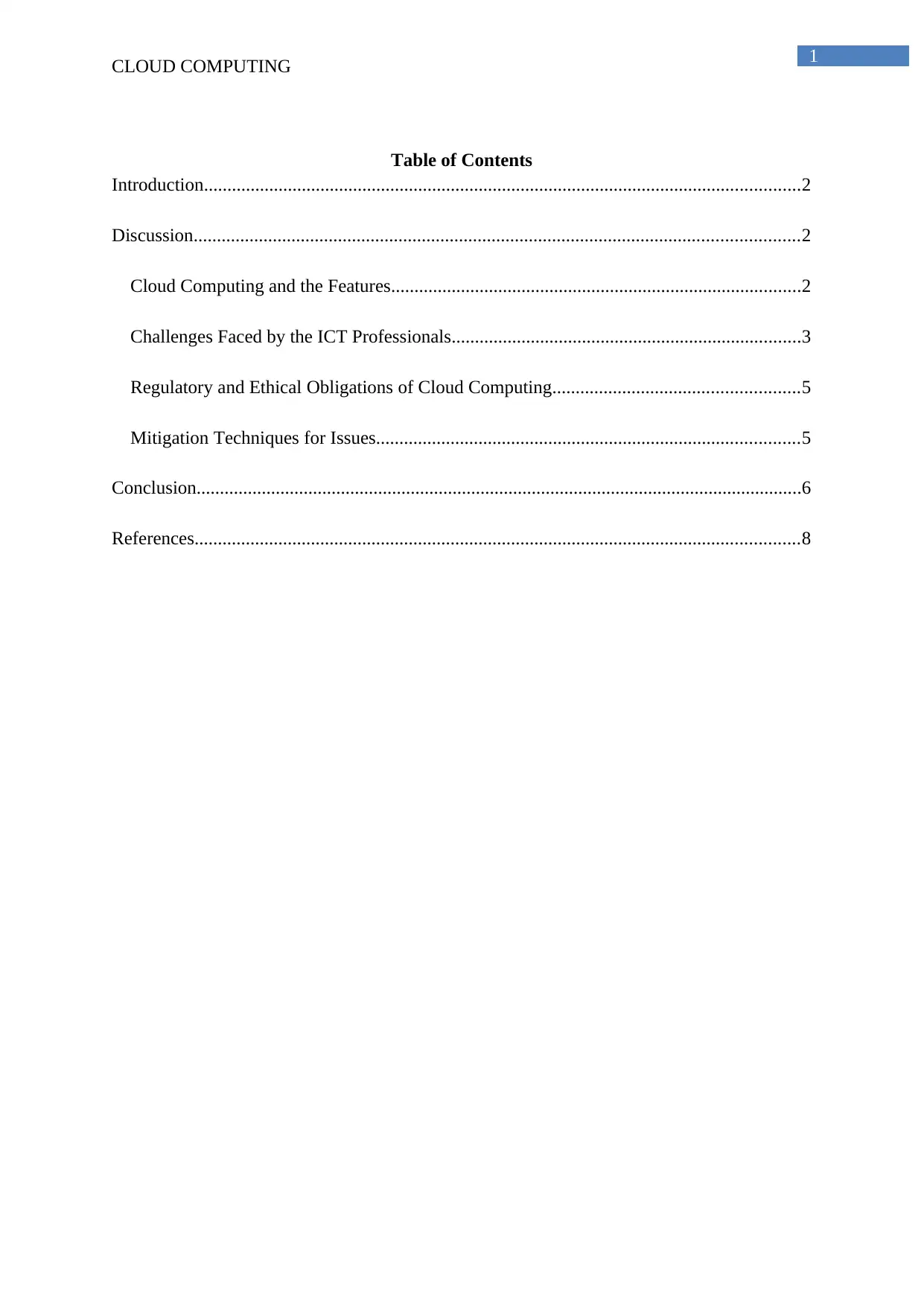
1
CLOUD COMPUTING
Table of Contents
Introduction................................................................................................................................2
Discussion..................................................................................................................................2
Cloud Computing and the Features........................................................................................2
Challenges Faced by the ICT Professionals...........................................................................3
Regulatory and Ethical Obligations of Cloud Computing.....................................................5
Mitigation Techniques for Issues...........................................................................................5
Conclusion..................................................................................................................................6
References..................................................................................................................................8
CLOUD COMPUTING
Table of Contents
Introduction................................................................................................................................2
Discussion..................................................................................................................................2
Cloud Computing and the Features........................................................................................2
Challenges Faced by the ICT Professionals...........................................................................3
Regulatory and Ethical Obligations of Cloud Computing.....................................................5
Mitigation Techniques for Issues...........................................................................................5
Conclusion..................................................................................................................................6
References..................................................................................................................................8
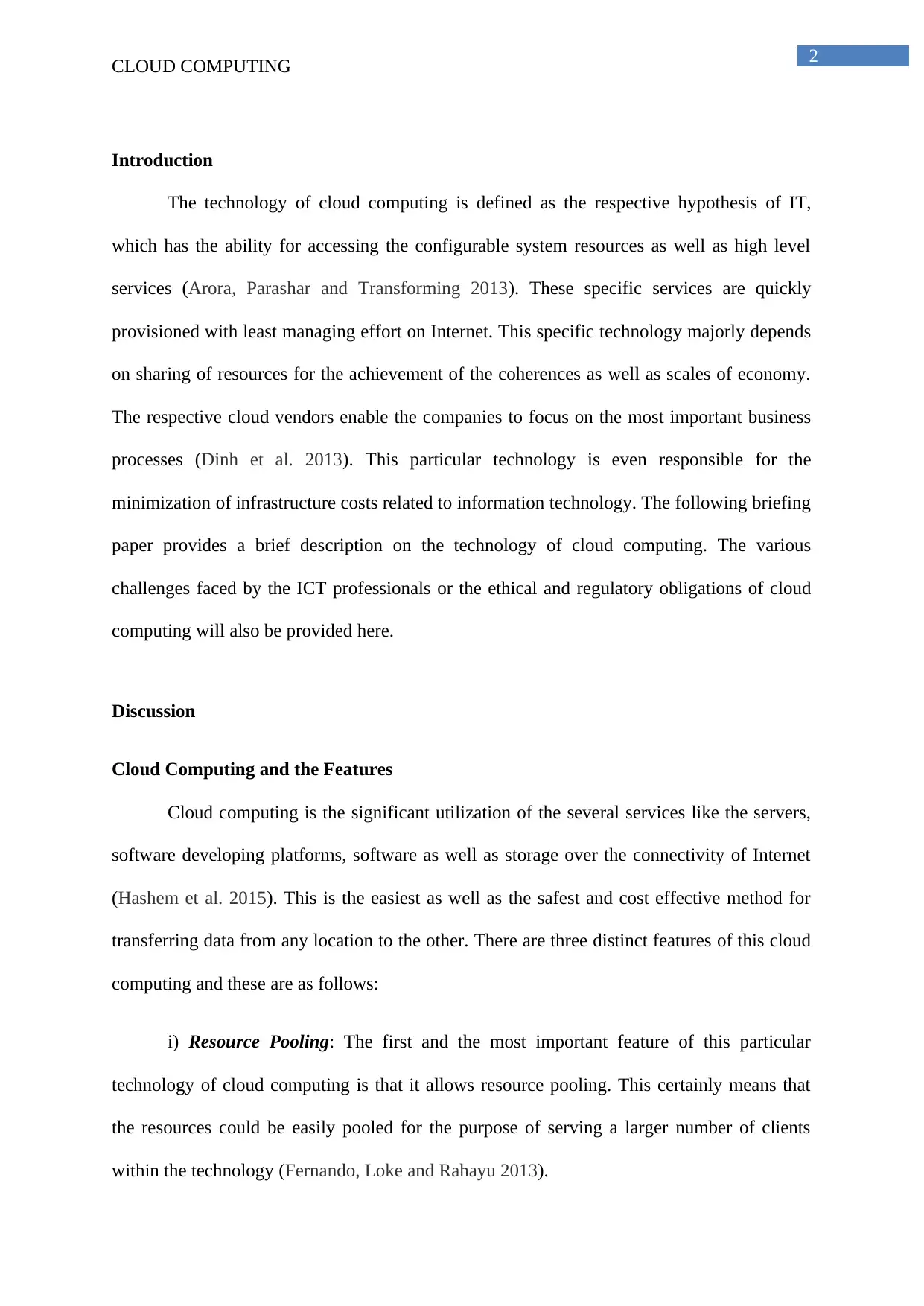
2
CLOUD COMPUTING
Introduction
The technology of cloud computing is defined as the respective hypothesis of IT,
which has the ability for accessing the configurable system resources as well as high level
services (Arora, Parashar and Transforming 2013). These specific services are quickly
provisioned with least managing effort on Internet. This specific technology majorly depends
on sharing of resources for the achievement of the coherences as well as scales of economy.
The respective cloud vendors enable the companies to focus on the most important business
processes (Dinh et al. 2013). This particular technology is even responsible for the
minimization of infrastructure costs related to information technology. The following briefing
paper provides a brief description on the technology of cloud computing. The various
challenges faced by the ICT professionals or the ethical and regulatory obligations of cloud
computing will also be provided here.
Discussion
Cloud Computing and the Features
Cloud computing is the significant utilization of the several services like the servers,
software developing platforms, software as well as storage over the connectivity of Internet
(Hashem et al. 2015). This is the easiest as well as the safest and cost effective method for
transferring data from any location to the other. There are three distinct features of this cloud
computing and these are as follows:
i) Resource Pooling: The first and the most important feature of this particular
technology of cloud computing is that it allows resource pooling. This certainly means that
the resources could be easily pooled for the purpose of serving a larger number of clients
within the technology (Fernando, Loke and Rahayu 2013).
CLOUD COMPUTING
Introduction
The technology of cloud computing is defined as the respective hypothesis of IT,
which has the ability for accessing the configurable system resources as well as high level
services (Arora, Parashar and Transforming 2013). These specific services are quickly
provisioned with least managing effort on Internet. This specific technology majorly depends
on sharing of resources for the achievement of the coherences as well as scales of economy.
The respective cloud vendors enable the companies to focus on the most important business
processes (Dinh et al. 2013). This particular technology is even responsible for the
minimization of infrastructure costs related to information technology. The following briefing
paper provides a brief description on the technology of cloud computing. The various
challenges faced by the ICT professionals or the ethical and regulatory obligations of cloud
computing will also be provided here.
Discussion
Cloud Computing and the Features
Cloud computing is the significant utilization of the several services like the servers,
software developing platforms, software as well as storage over the connectivity of Internet
(Hashem et al. 2015). This is the easiest as well as the safest and cost effective method for
transferring data from any location to the other. There are three distinct features of this cloud
computing and these are as follows:
i) Resource Pooling: The first and the most important feature of this particular
technology of cloud computing is that it allows resource pooling. This certainly means that
the resources could be easily pooled for the purpose of serving a larger number of clients
within the technology (Fernando, Loke and Rahayu 2013).
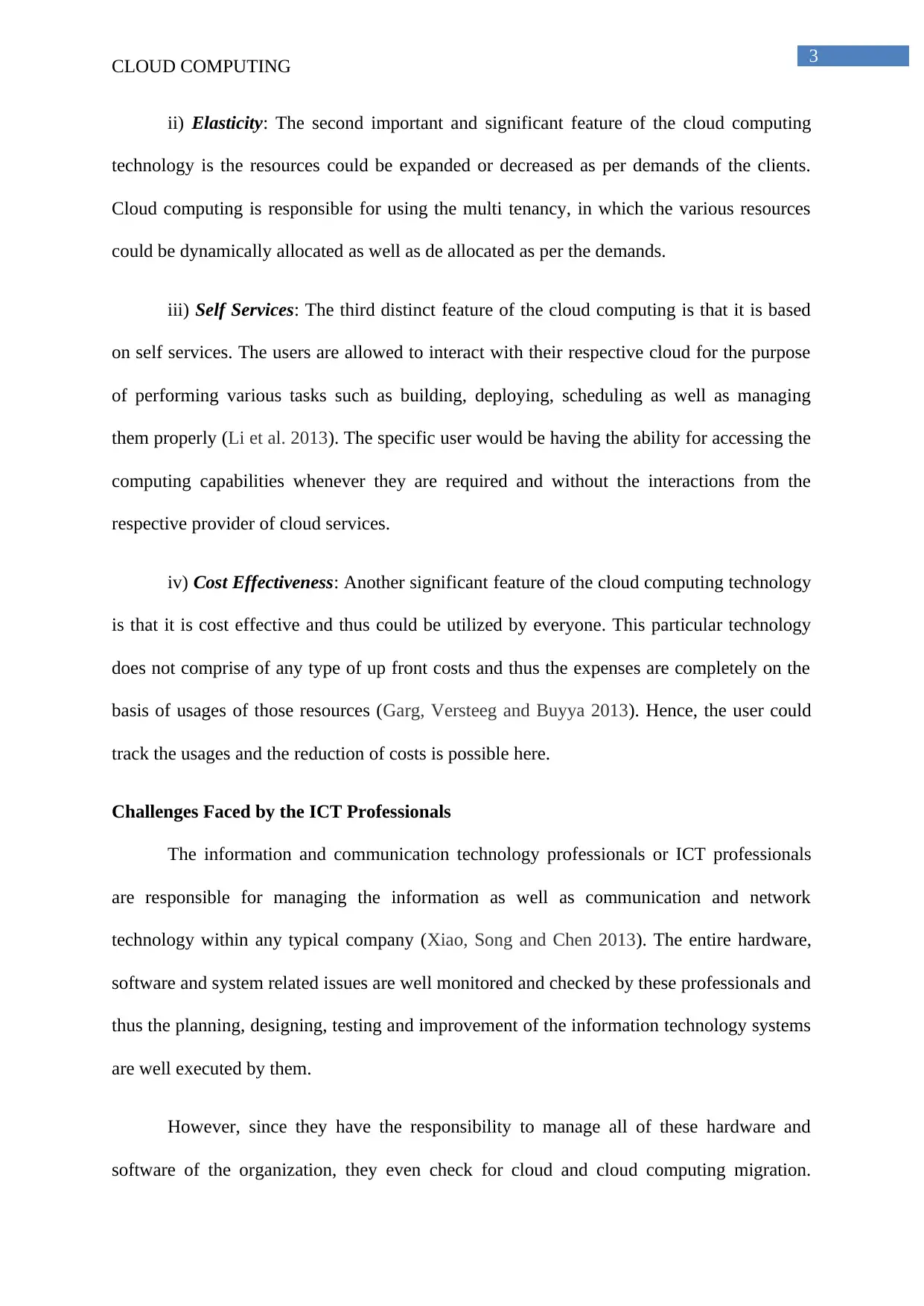
3
CLOUD COMPUTING
ii) Elasticity: The second important and significant feature of the cloud computing
technology is the resources could be expanded or decreased as per demands of the clients.
Cloud computing is responsible for using the multi tenancy, in which the various resources
could be dynamically allocated as well as de allocated as per the demands.
iii) Self Services: The third distinct feature of the cloud computing is that it is based
on self services. The users are allowed to interact with their respective cloud for the purpose
of performing various tasks such as building, deploying, scheduling as well as managing
them properly (Li et al. 2013). The specific user would be having the ability for accessing the
computing capabilities whenever they are required and without the interactions from the
respective provider of cloud services.
iv) Cost Effectiveness: Another significant feature of the cloud computing technology
is that it is cost effective and thus could be utilized by everyone. This particular technology
does not comprise of any type of up front costs and thus the expenses are completely on the
basis of usages of those resources (Garg, Versteeg and Buyya 2013). Hence, the user could
track the usages and the reduction of costs is possible here.
Challenges Faced by the ICT Professionals
The information and communication technology professionals or ICT professionals
are responsible for managing the information as well as communication and network
technology within any typical company (Xiao, Song and Chen 2013). The entire hardware,
software and system related issues are well monitored and checked by these professionals and
thus the planning, designing, testing and improvement of the information technology systems
are well executed by them.
However, since they have the responsibility to manage all of these hardware and
software of the organization, they even check for cloud and cloud computing migration.
CLOUD COMPUTING
ii) Elasticity: The second important and significant feature of the cloud computing
technology is the resources could be expanded or decreased as per demands of the clients.
Cloud computing is responsible for using the multi tenancy, in which the various resources
could be dynamically allocated as well as de allocated as per the demands.
iii) Self Services: The third distinct feature of the cloud computing is that it is based
on self services. The users are allowed to interact with their respective cloud for the purpose
of performing various tasks such as building, deploying, scheduling as well as managing
them properly (Li et al. 2013). The specific user would be having the ability for accessing the
computing capabilities whenever they are required and without the interactions from the
respective provider of cloud services.
iv) Cost Effectiveness: Another significant feature of the cloud computing technology
is that it is cost effective and thus could be utilized by everyone. This particular technology
does not comprise of any type of up front costs and thus the expenses are completely on the
basis of usages of those resources (Garg, Versteeg and Buyya 2013). Hence, the user could
track the usages and the reduction of costs is possible here.
Challenges Faced by the ICT Professionals
The information and communication technology professionals or ICT professionals
are responsible for managing the information as well as communication and network
technology within any typical company (Xiao, Song and Chen 2013). The entire hardware,
software and system related issues are well monitored and checked by these professionals and
thus the planning, designing, testing and improvement of the information technology systems
are well executed by them.
However, since they have the responsibility to manage all of these hardware and
software of the organization, they even check for cloud and cloud computing migration.
Secure Best Marks with AI Grader
Need help grading? Try our AI Grader for instant feedback on your assignments.

4
CLOUD COMPUTING
There are some of the major challenges of cloud computing that are faced by these ICT
professionals (Jain and Paul 2013). The most noteworthy and popular challenges of the cloud
computing technology that are faced by ICT professionals are given below:
i) Reliability of Service Providers: The first and the foremost challenge that these
professionals often go through is the reliability checking of the service providers of cloud.
These service providers of cloud are the vendors that supply cloud computing or the cloud, on
which any activity is executed (Botta et al. 2016). The capability as well as the capacity of
the technical service providers is more vital for the ICT professionals. If they will not be
reliable enough, there is a high chance the data would be lost.
ii) Implementation Costs: The second important challenge that these ICT
professionals often face while using cloud computing is the excess or higher implementation
costs. Although, the technology of cloud computing is cost effective in nature, the overall
implementation costs of this particular technology is extremely high and hence the smaller
organizations could not afford them easily (Herbst, Kounev and Reussner 2013). Cloud
computing is thus considered as the best solution for the large as well as medium companies.
iii) Downtime: The next important challenge of cloud computing that the ICT
professionals face in their organizations is the downtime. This is one of the major
shortcomings of this technology. Not a single cloud platform is free from the possible
downtime.
iv) Security: Security is the next significant issue that is faced by the ICT
professionals while utilizing this technology of cloud computing (Wei et al. 2014). There is
always a great chance that confidential data will be lost.
CLOUD COMPUTING
There are some of the major challenges of cloud computing that are faced by these ICT
professionals (Jain and Paul 2013). The most noteworthy and popular challenges of the cloud
computing technology that are faced by ICT professionals are given below:
i) Reliability of Service Providers: The first and the foremost challenge that these
professionals often go through is the reliability checking of the service providers of cloud.
These service providers of cloud are the vendors that supply cloud computing or the cloud, on
which any activity is executed (Botta et al. 2016). The capability as well as the capacity of
the technical service providers is more vital for the ICT professionals. If they will not be
reliable enough, there is a high chance the data would be lost.
ii) Implementation Costs: The second important challenge that these ICT
professionals often face while using cloud computing is the excess or higher implementation
costs. Although, the technology of cloud computing is cost effective in nature, the overall
implementation costs of this particular technology is extremely high and hence the smaller
organizations could not afford them easily (Herbst, Kounev and Reussner 2013). Cloud
computing is thus considered as the best solution for the large as well as medium companies.
iii) Downtime: The next important challenge of cloud computing that the ICT
professionals face in their organizations is the downtime. This is one of the major
shortcomings of this technology. Not a single cloud platform is free from the possible
downtime.
iv) Security: Security is the next significant issue that is faced by the ICT
professionals while utilizing this technology of cloud computing (Wei et al. 2014). There is
always a great chance that confidential data will be lost.
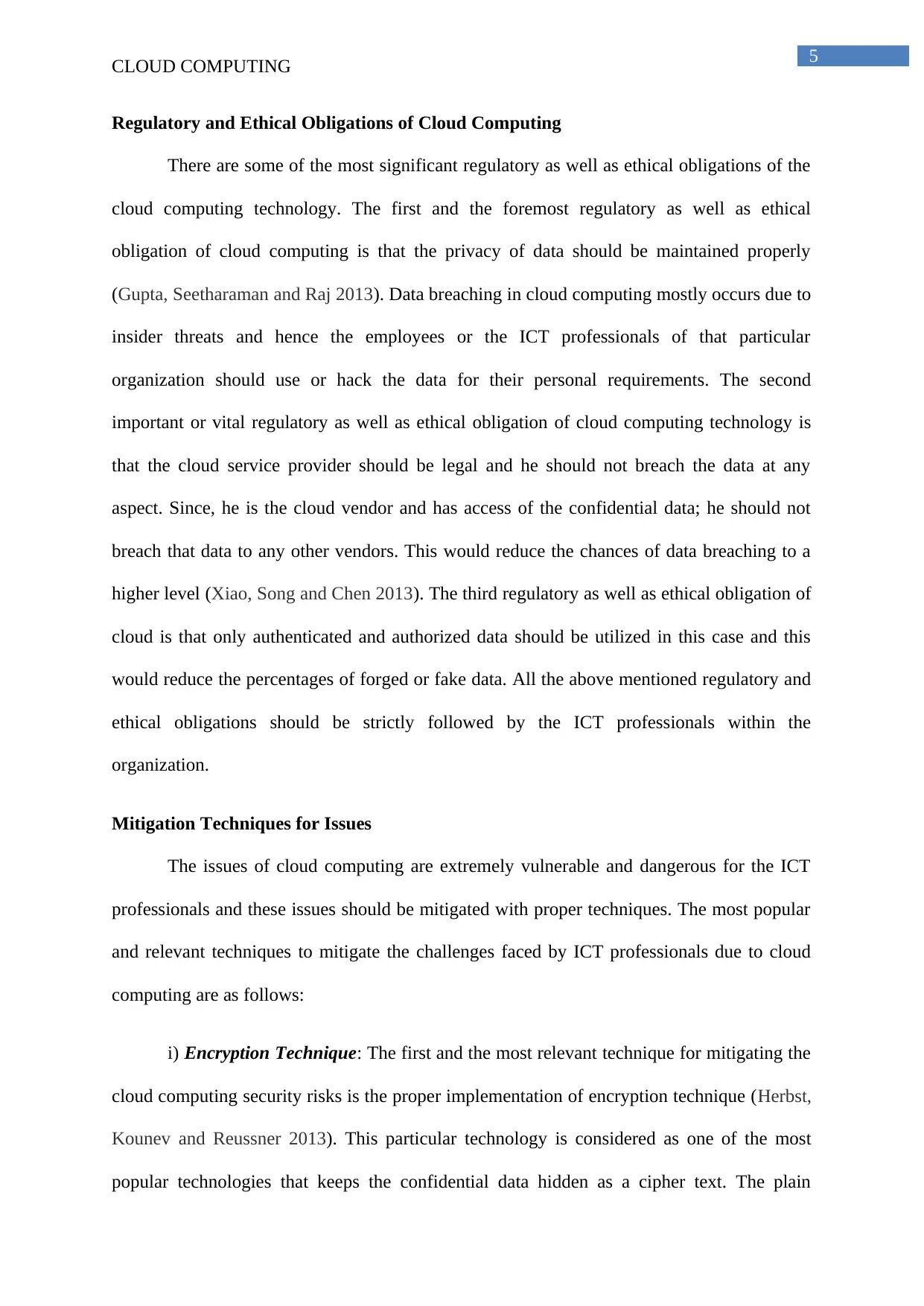
5
CLOUD COMPUTING
Regulatory and Ethical Obligations of Cloud Computing
There are some of the most significant regulatory as well as ethical obligations of the
cloud computing technology. The first and the foremost regulatory as well as ethical
obligation of cloud computing is that the privacy of data should be maintained properly
(Gupta, Seetharaman and Raj 2013). Data breaching in cloud computing mostly occurs due to
insider threats and hence the employees or the ICT professionals of that particular
organization should use or hack the data for their personal requirements. The second
important or vital regulatory as well as ethical obligation of cloud computing technology is
that the cloud service provider should be legal and he should not breach the data at any
aspect. Since, he is the cloud vendor and has access of the confidential data; he should not
breach that data to any other vendors. This would reduce the chances of data breaching to a
higher level (Xiao, Song and Chen 2013). The third regulatory as well as ethical obligation of
cloud is that only authenticated and authorized data should be utilized in this case and this
would reduce the percentages of forged or fake data. All the above mentioned regulatory and
ethical obligations should be strictly followed by the ICT professionals within the
organization.
Mitigation Techniques for Issues
The issues of cloud computing are extremely vulnerable and dangerous for the ICT
professionals and these issues should be mitigated with proper techniques. The most popular
and relevant techniques to mitigate the challenges faced by ICT professionals due to cloud
computing are as follows:
i) Encryption Technique: The first and the most relevant technique for mitigating the
cloud computing security risks is the proper implementation of encryption technique (Herbst,
Kounev and Reussner 2013). This particular technology is considered as one of the most
popular technologies that keeps the confidential data hidden as a cipher text. The plain
CLOUD COMPUTING
Regulatory and Ethical Obligations of Cloud Computing
There are some of the most significant regulatory as well as ethical obligations of the
cloud computing technology. The first and the foremost regulatory as well as ethical
obligation of cloud computing is that the privacy of data should be maintained properly
(Gupta, Seetharaman and Raj 2013). Data breaching in cloud computing mostly occurs due to
insider threats and hence the employees or the ICT professionals of that particular
organization should use or hack the data for their personal requirements. The second
important or vital regulatory as well as ethical obligation of cloud computing technology is
that the cloud service provider should be legal and he should not breach the data at any
aspect. Since, he is the cloud vendor and has access of the confidential data; he should not
breach that data to any other vendors. This would reduce the chances of data breaching to a
higher level (Xiao, Song and Chen 2013). The third regulatory as well as ethical obligation of
cloud is that only authenticated and authorized data should be utilized in this case and this
would reduce the percentages of forged or fake data. All the above mentioned regulatory and
ethical obligations should be strictly followed by the ICT professionals within the
organization.
Mitigation Techniques for Issues
The issues of cloud computing are extremely vulnerable and dangerous for the ICT
professionals and these issues should be mitigated with proper techniques. The most popular
and relevant techniques to mitigate the challenges faced by ICT professionals due to cloud
computing are as follows:
i) Encryption Technique: The first and the most relevant technique for mitigating the
cloud computing security risks is the proper implementation of encryption technique (Herbst,
Kounev and Reussner 2013). This particular technology is considered as one of the most
popular technologies that keeps the confidential data hidden as a cipher text. The plain
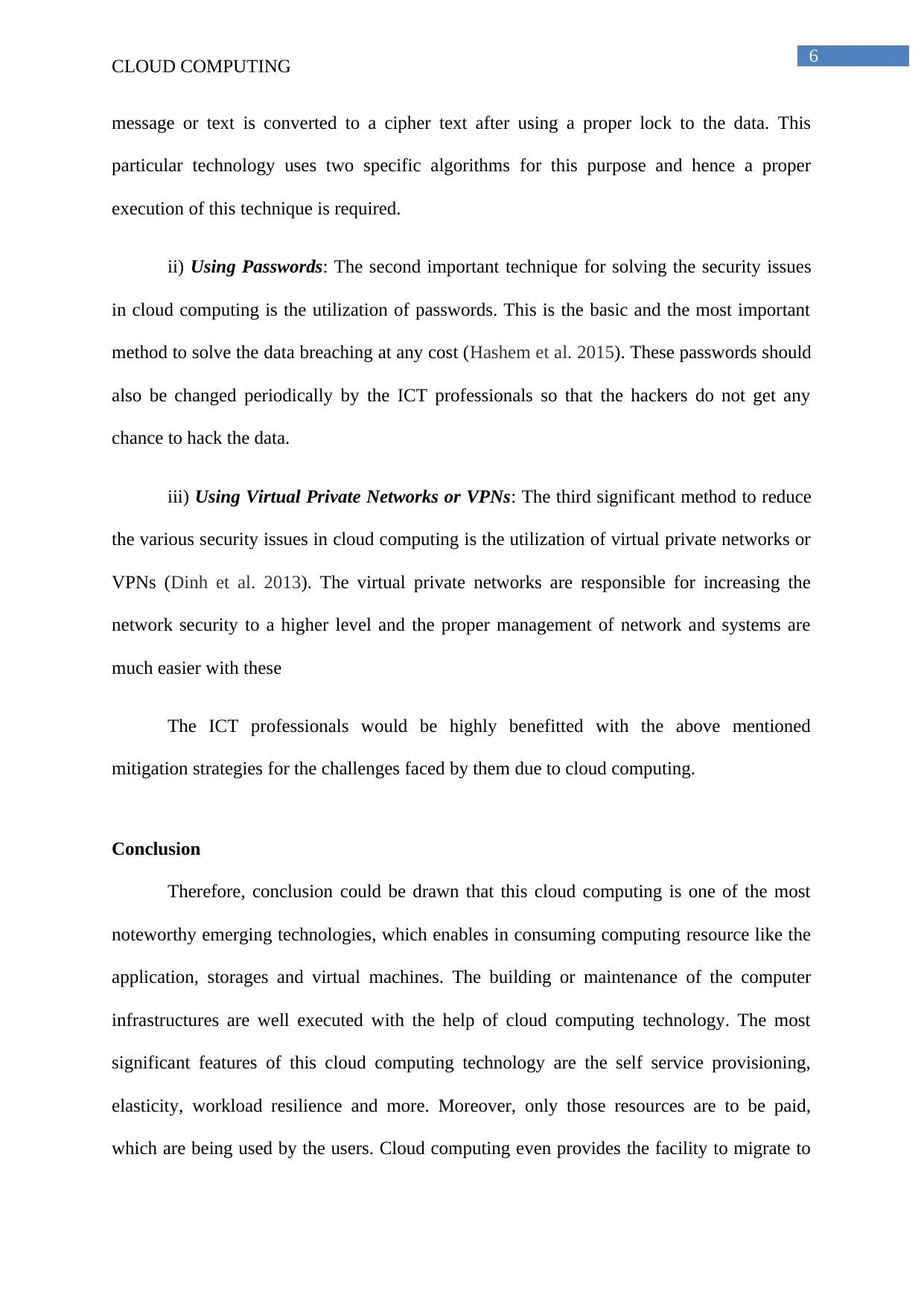
6
CLOUD COMPUTING
message or text is converted to a cipher text after using a proper lock to the data. This
particular technology uses two specific algorithms for this purpose and hence a proper
execution of this technique is required.
ii) Using Passwords: The second important technique for solving the security issues
in cloud computing is the utilization of passwords. This is the basic and the most important
method to solve the data breaching at any cost (Hashem et al. 2015). These passwords should
also be changed periodically by the ICT professionals so that the hackers do not get any
chance to hack the data.
iii) Using Virtual Private Networks or VPNs: The third significant method to reduce
the various security issues in cloud computing is the utilization of virtual private networks or
VPNs (Dinh et al. 2013). The virtual private networks are responsible for increasing the
network security to a higher level and the proper management of network and systems are
much easier with these
The ICT professionals would be highly benefitted with the above mentioned
mitigation strategies for the challenges faced by them due to cloud computing.
Conclusion
Therefore, conclusion could be drawn that this cloud computing is one of the most
noteworthy emerging technologies, which enables in consuming computing resource like the
application, storages and virtual machines. The building or maintenance of the computer
infrastructures are well executed with the help of cloud computing technology. The most
significant features of this cloud computing technology are the self service provisioning,
elasticity, workload resilience and more. Moreover, only those resources are to be paid,
which are being used by the users. Cloud computing even provides the facility to migrate to
CLOUD COMPUTING
message or text is converted to a cipher text after using a proper lock to the data. This
particular technology uses two specific algorithms for this purpose and hence a proper
execution of this technique is required.
ii) Using Passwords: The second important technique for solving the security issues
in cloud computing is the utilization of passwords. This is the basic and the most important
method to solve the data breaching at any cost (Hashem et al. 2015). These passwords should
also be changed periodically by the ICT professionals so that the hackers do not get any
chance to hack the data.
iii) Using Virtual Private Networks or VPNs: The third significant method to reduce
the various security issues in cloud computing is the utilization of virtual private networks or
VPNs (Dinh et al. 2013). The virtual private networks are responsible for increasing the
network security to a higher level and the proper management of network and systems are
much easier with these
The ICT professionals would be highly benefitted with the above mentioned
mitigation strategies for the challenges faced by them due to cloud computing.
Conclusion
Therefore, conclusion could be drawn that this cloud computing is one of the most
noteworthy emerging technologies, which enables in consuming computing resource like the
application, storages and virtual machines. The building or maintenance of the computer
infrastructures are well executed with the help of cloud computing technology. The most
significant features of this cloud computing technology are the self service provisioning,
elasticity, workload resilience and more. Moreover, only those resources are to be paid,
which are being used by the users. Cloud computing even provides the facility to migrate to
Paraphrase This Document
Need a fresh take? Get an instant paraphrase of this document with our AI Paraphraser

7
CLOUD COMPUTING
any specific cloud platform eventually without incurring serious complexities and costs.
Several security issues are also present within this technology, which makes it much difficult
to handle for the users. The above briefing paper has clearly outlined the various challenges
of cloud computing that are vulnerable for the ICT professionals. These ICT professionals
even face the socio technical or ethical obligations related to cloud computing. All the above
mentioned factors are well explained in this briefing paper.
CLOUD COMPUTING
any specific cloud platform eventually without incurring serious complexities and costs.
Several security issues are also present within this technology, which makes it much difficult
to handle for the users. The above briefing paper has clearly outlined the various challenges
of cloud computing that are vulnerable for the ICT professionals. These ICT professionals
even face the socio technical or ethical obligations related to cloud computing. All the above
mentioned factors are well explained in this briefing paper.
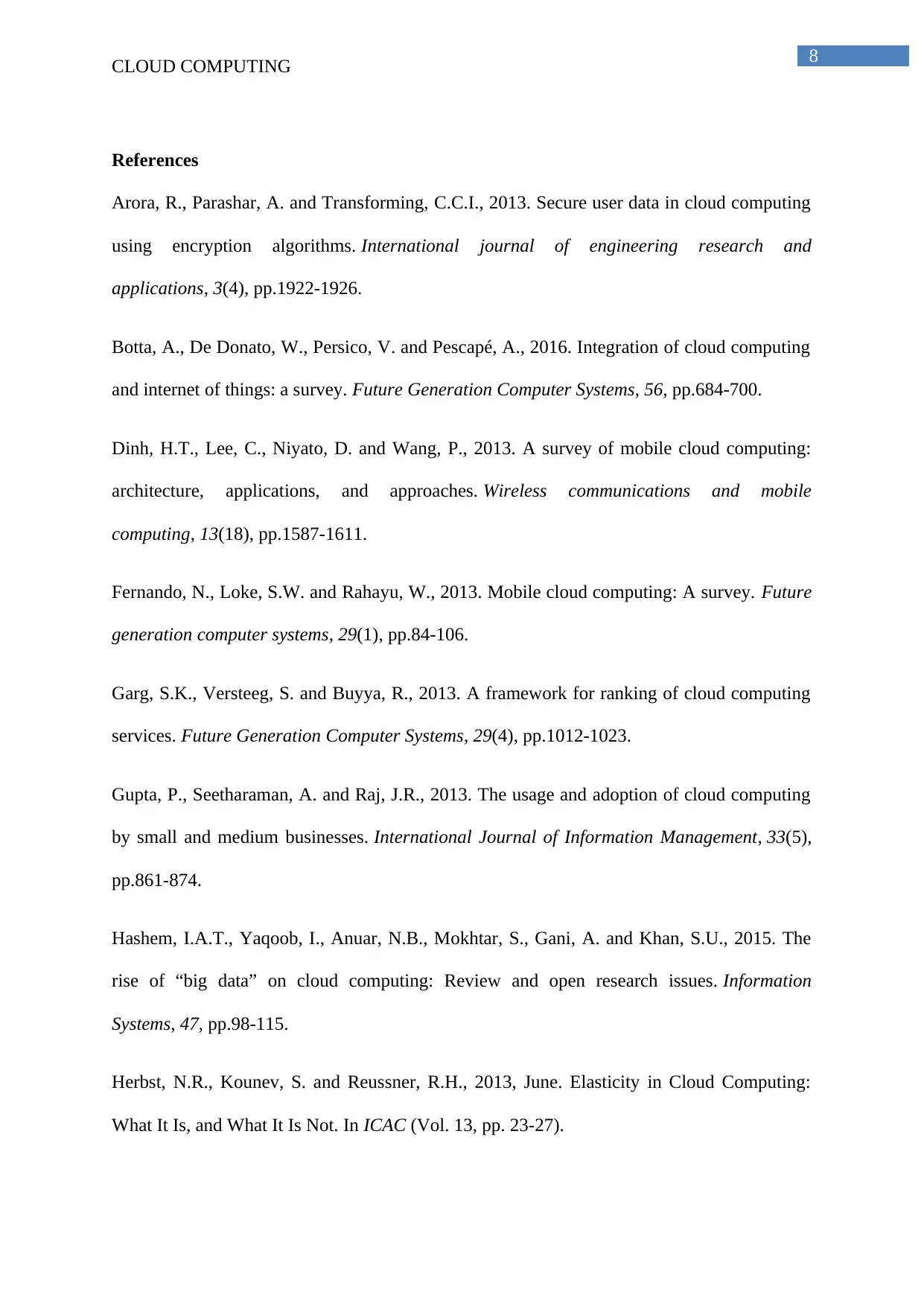
8
CLOUD COMPUTING
References
Arora, R., Parashar, A. and Transforming, C.C.I., 2013. Secure user data in cloud computing
using encryption algorithms. International journal of engineering research and
applications, 3(4), pp.1922-1926.
Botta, A., De Donato, W., Persico, V. and Pescapé, A., 2016. Integration of cloud computing
and internet of things: a survey. Future Generation Computer Systems, 56, pp.684-700.
Dinh, H.T., Lee, C., Niyato, D. and Wang, P., 2013. A survey of mobile cloud computing:
architecture, applications, and approaches. Wireless communications and mobile
computing, 13(18), pp.1587-1611.
Fernando, N., Loke, S.W. and Rahayu, W., 2013. Mobile cloud computing: A survey. Future
generation computer systems, 29(1), pp.84-106.
Garg, S.K., Versteeg, S. and Buyya, R., 2013. A framework for ranking of cloud computing
services. Future Generation Computer Systems, 29(4), pp.1012-1023.
Gupta, P., Seetharaman, A. and Raj, J.R., 2013. The usage and adoption of cloud computing
by small and medium businesses. International Journal of Information Management, 33(5),
pp.861-874.
Hashem, I.A.T., Yaqoob, I., Anuar, N.B., Mokhtar, S., Gani, A. and Khan, S.U., 2015. The
rise of “big data” on cloud computing: Review and open research issues. Information
Systems, 47, pp.98-115.
Herbst, N.R., Kounev, S. and Reussner, R.H., 2013, June. Elasticity in Cloud Computing:
What It Is, and What It Is Not. In ICAC (Vol. 13, pp. 23-27).
CLOUD COMPUTING
References
Arora, R., Parashar, A. and Transforming, C.C.I., 2013. Secure user data in cloud computing
using encryption algorithms. International journal of engineering research and
applications, 3(4), pp.1922-1926.
Botta, A., De Donato, W., Persico, V. and Pescapé, A., 2016. Integration of cloud computing
and internet of things: a survey. Future Generation Computer Systems, 56, pp.684-700.
Dinh, H.T., Lee, C., Niyato, D. and Wang, P., 2013. A survey of mobile cloud computing:
architecture, applications, and approaches. Wireless communications and mobile
computing, 13(18), pp.1587-1611.
Fernando, N., Loke, S.W. and Rahayu, W., 2013. Mobile cloud computing: A survey. Future
generation computer systems, 29(1), pp.84-106.
Garg, S.K., Versteeg, S. and Buyya, R., 2013. A framework for ranking of cloud computing
services. Future Generation Computer Systems, 29(4), pp.1012-1023.
Gupta, P., Seetharaman, A. and Raj, J.R., 2013. The usage and adoption of cloud computing
by small and medium businesses. International Journal of Information Management, 33(5),
pp.861-874.
Hashem, I.A.T., Yaqoob, I., Anuar, N.B., Mokhtar, S., Gani, A. and Khan, S.U., 2015. The
rise of “big data” on cloud computing: Review and open research issues. Information
Systems, 47, pp.98-115.
Herbst, N.R., Kounev, S. and Reussner, R.H., 2013, June. Elasticity in Cloud Computing:
What It Is, and What It Is Not. In ICAC (Vol. 13, pp. 23-27).
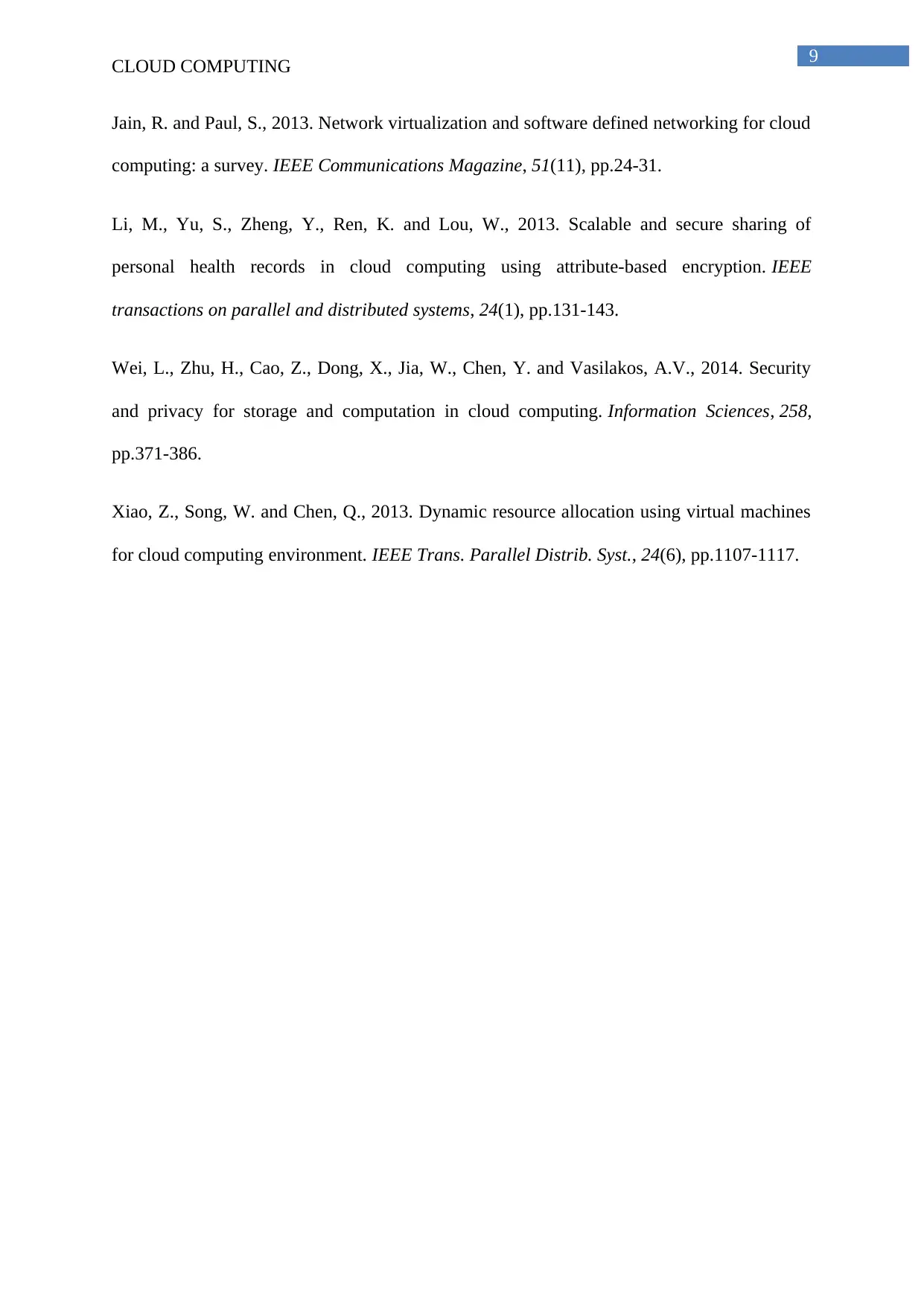
9
CLOUD COMPUTING
Jain, R. and Paul, S., 2013. Network virtualization and software defined networking for cloud
computing: a survey. IEEE Communications Magazine, 51(11), pp.24-31.
Li, M., Yu, S., Zheng, Y., Ren, K. and Lou, W., 2013. Scalable and secure sharing of
personal health records in cloud computing using attribute-based encryption. IEEE
transactions on parallel and distributed systems, 24(1), pp.131-143.
Wei, L., Zhu, H., Cao, Z., Dong, X., Jia, W., Chen, Y. and Vasilakos, A.V., 2014. Security
and privacy for storage and computation in cloud computing. Information Sciences, 258,
pp.371-386.
Xiao, Z., Song, W. and Chen, Q., 2013. Dynamic resource allocation using virtual machines
for cloud computing environment. IEEE Trans. Parallel Distrib. Syst., 24(6), pp.1107-1117.
CLOUD COMPUTING
Jain, R. and Paul, S., 2013. Network virtualization and software defined networking for cloud
computing: a survey. IEEE Communications Magazine, 51(11), pp.24-31.
Li, M., Yu, S., Zheng, Y., Ren, K. and Lou, W., 2013. Scalable and secure sharing of
personal health records in cloud computing using attribute-based encryption. IEEE
transactions on parallel and distributed systems, 24(1), pp.131-143.
Wei, L., Zhu, H., Cao, Z., Dong, X., Jia, W., Chen, Y. and Vasilakos, A.V., 2014. Security
and privacy for storage and computation in cloud computing. Information Sciences, 258,
pp.371-386.
Xiao, Z., Song, W. and Chen, Q., 2013. Dynamic resource allocation using virtual machines
for cloud computing environment. IEEE Trans. Parallel Distrib. Syst., 24(6), pp.1107-1117.
1 out of 10
Related Documents
Your All-in-One AI-Powered Toolkit for Academic Success.
+13062052269
info@desklib.com
Available 24*7 on WhatsApp / Email
![[object Object]](/_next/static/media/star-bottom.7253800d.svg)
Unlock your academic potential
© 2024 | Zucol Services PVT LTD | All rights reserved.




